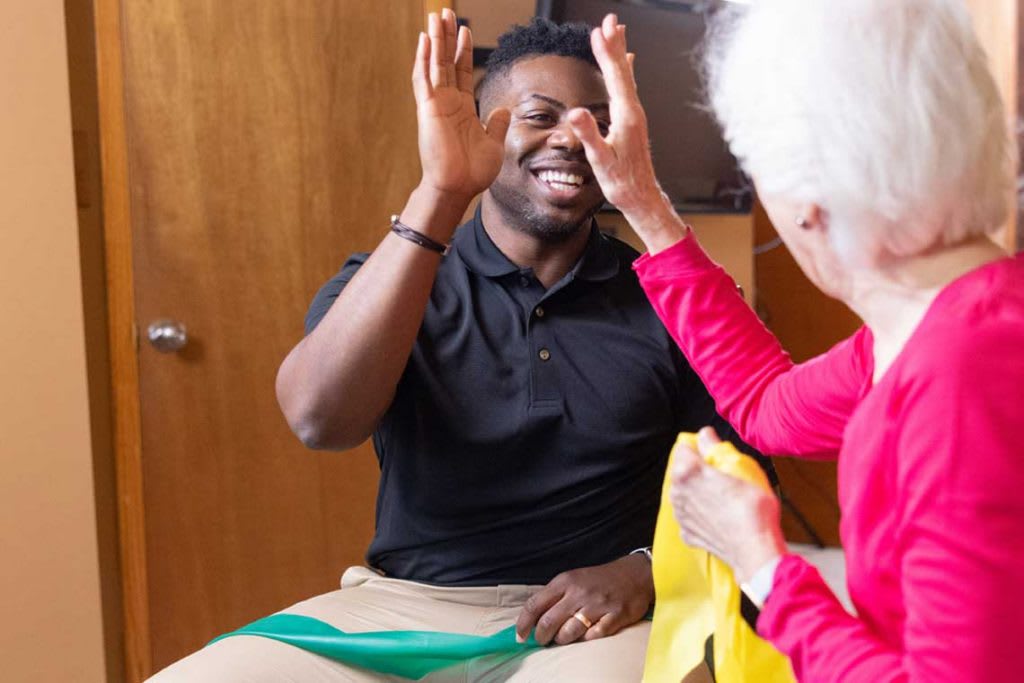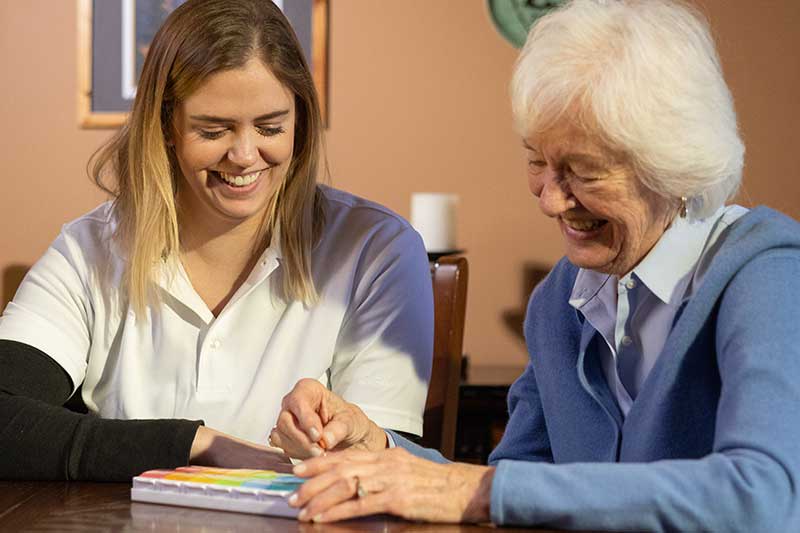What Is an OTA?
Each blog post is dated and contains accurate information as of that date. Certain information may have changed since the blog post publication date. If you would like to confirm the current accuracy of blog information, please visit our Online OTA program overview page or contact us at (877) 223-2677.
An OTA, or occupational therapy assistant, works with clients to improve their quality of life. The demand for OTAs is growing, making it a very marketable career. If you enjoy helping others and making an impact through creative problem-solving, a career as an OTA could be right for you.

The healthcare industry offers many job opportunities for first-time students and career changers. But there is one healthcare career that stands out from the rest because of its diversity, growth and high demand: occupational therapy assistants (OTAs). The St. Catherine University Online OTA program can help you join this growing healthcare field.
OTA is among the top healthcare jobs in demand right now. In fact, U.S News & World Report ranked OTA the No. 1 best healthcare support job in 2023. It’s one of the fastest-growing healthcare jobs you can have with an associate’s degree and, according to the Bureau of Labor Statistics, the OTA profession will grow 25% by 2031, faster than almost any other occupation.
What Is an Occupational Therapy Assistant?
Occupational therapy assistants work under the guidance of occupational therapists (OTs) in various practice areas and settings. The primary goal of occupational therapy is to help clients with injuries, illnesses or disabilities learn how to perform everyday tasks as independently as possible. While OTs evaluate client needs and develop treatment plans, OTAs put those plans into action with their clients and document their progress.

Interested in a career in occupational therapy? Here are seven reasons to become an OTA.
A Career Helping People
A career as an OTA is unique in that it empowers you to make a difference. As an OTA you’ll get to solve problems in novel ways and tailor treatment plans to your clients’ specific needs. You’ll guide them through challenges and help them overcome obstacles. The impact you make on your clients’ lives can have lasting effects and even change their outlook in the face of hardship.
Take for example, the story of Stephanie Adams, Program Director at St. Kate’s.
Stephanie’s Story: Making a Difference as an OTA
“When I was starting out as an OTA, I was working in a hospital and there was one client I just fell in love with because she was so genuine and so willing to overcome her challenges. She had a stroke, and all she wanted to do was to be able to go home and cook for her family. The one thing she wanted to cook was fried green tomatoes. I went home that night, went by the store and I got the supplies for the dish. I came back the next day, and I was like, okay, we're going to make fried green tomatoes today. She teared up, she was so excited to do something that was very meaningful for her. I feel like that client changed my perspective about OT, and showed me how it was very client-centered.
It was a very emotional session. You can learn so much from your clients, always. If you step back and just listen, you can learn so much more from them than you know, or even more than what you might have learned in your books.”
Want to learn more? Check out these six occupational therapy specialties.

OTA History
As in demand as OTAs are right now, many people have still never heard of the profession. But its history can be traced back to 100 BCE when Greek physician Asclepiades used therapeutic baths, massage, exercise, and music to help treat his patients. It evolved into a type of treatment for people with mental illness, focused on using purposeful activity to improve both mental and physical health.
Occupational therapy became a profession in 1917, in the midst of World War I, as the demand increased for occupational therapists to help wounded soldiers heal and return home. The field continued to grow and develop in the decades following WWI, expanding into the areas of physical rehabilitation, pediatrics and community programs.
In 1964, St. Catherine University established the nation’s first non-profit, accredited Occupational Therapy Assistant Program. St. Catherine’s OTA program continued to innovate and also developed a first-of-its-kind OTA program that combines online learning with hands-on skills labs and fieldwork.
OTA Practice Areas
The field of occupational therapy encompasses several core practice areas. As a certified occupational therapy assistant, you’ll find yourself treating clients of all ages in a wide variety of settings. Whether you want to specialize in one area, work as a generalist or even change practice areas during your career, there are many different types of opportunities in occupational therapy.
Pediatrics
Some OTAs work with children in schools or in outpatient clinics to help them gain skills needed to participate in the daily occupations of children including classroom and play activities.
Geriatrics and Productive Aging
OTAs work with older adults with age-related impairments such as dementia, arthritis, or vision loss. They may work with clients to prevent falls, provide adaptive equipment, and engage in activities they find meaningful.

Health and Wellness
An OTA might help a client with a chronic illness, such as rheumatoid arthritis (RA) or type 2 diabetes with a plan to improve their overall health and wellness. A plan for a client with RA could include managing stiffness, fatigue, and inflammation and the use of adaptive equipment, such as orthotic devices. They also may help with managing stress and identifying community resources for additional support.
Mental Health
OTAs work with people with mental health conditions, such as depression or anxiety. Some OTAs may work in a setting providing psychiatric care. Other OTAs may find clients experiencing mental health conditions, in other settings, impacting their recovery from an illness or injury. They assist their clients to identify interventions to help them manage their symptoms and improve their daily functioning.
Rehabilitation
OTAs provide therapy in both inpatient and outpatient rehabilitation settings. They work with individuals with a wide variety of diagnoses such as stroke, traumatic brain injury, Parkinson’s disease, Multiple sclerosis, cancer, or orthopedic injuries. Treatment may include activities designed to improve hand and arm function, mobility, vision, cognition, or community reintegration.
OTA Practice Settings
Occupational therapy assistants can work full-time or part-time in a variety of practice settings including:
- Homes
- Hospitals
- Rehabilitation centers
- Schools
- Skilled nursing facilities
How to Become an OTA

No matter what your educational background is, St. Catherine University can get you moving on a quality OTA degree. While it is possible to graduate from this associate degree program in as few as 16 months, the timeframe for your completion ultimately depends on your level of prior coursework and your individual needs.
Start Your Rewarding Career as an OTA Now
Healthcare jobs like occupational therapy assistants are in demand, so now is the perfect opportunity to seize the moment and your future.
If you are ready to take the next step now to find out if St. Kate’s online OTA program is the right fit for you, contact our admissions counselors today.


